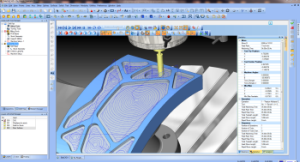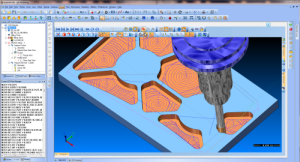Traditional Offset Pocketing vs. High Speed Adaptive Pocketing
By employing the use of High Speed Adaptive toolpaths into your machining operations you can achieve excellent results faster than by using traditional offset toolpaths and it’s not only 2.5 Axis pocketing any longer. The latest achievements in CAD-CAM software include High Speed Machining operations for 3 Axis as well as 4 and even 5th Axis CNC Milling. The HS Adaptive Roughing operations available in the latest BobCAD-CAM 3 Axis Mill Standard and Pro versions are accessible in the software machining wizards that remove the guesswork from programming and enhance the user experience. The following CAM Clip video shows a side by side comparison between these two machining operations.
Traditional offset toolpath has been the most common form of toolpath in use since the creation of CAM software. However, as more and more shops begin to use HSM they are trusting it more, becoming less critical and beginning to enjoy the benefits of it. The goal of using a trochoidal form of machine path is to limit the number of collisions that the cutting edge of the tool has with the material, reducing chip load, better utilize the cutting tool itself by using more of it while taking deeper cut depths and all while at much higher speeds and to maximize material removal through constant tool engagement.
High Speed machine toolpath strategies open the door to a number of important benefits:
1. The controlled arc of engagement generates low cutting forces which enable high axial depths of cut. Multi-edged tools can be used which enable high table feeds with secure tool life. In other words, deeper cuts can be achieved easily.
2. The whole cutting edge length can be utilized ensuring that the heat and wear are uniform and spread out, leading to longer tool life.
3. There is a constant tool engagement, deeper cutting and NO stop and go.
4. High Speed toolpaths are excellent for slotting and pocketing when vibration is a problem.
5. Much higher speeds are used resulting in superior finishes due to a number of factors (reduced tool deflection, vibration/chatter etc.) while machine cycle times are vastly reduced. Shorter cycle times on jobs.
High speed machining can certainly help a shop manufacture more accurate parts with better surface finishes. And often, because a machine tool and workpiece setup has to be very rigid for high speed machining, the results are more consistent workpieces. All of this together amounting to higher efficiency in CNC programs, machining and in the end, increased profitability for a CNC business.
 CAD-CAM software is an absolute necessity for the creation of these types of machining toolpaths. Without CAD-CAM software they wouldn’t exist today. The benefits listed here outline all of the reasons why shops should take advantage of this technology. And now, high speed adaptive roughing strategies are being made available in BobCAD-CAM for Multiaxis CNC machining for the first time, opening the door for even more complex CNC work to take advantage of its powerful abilities and profit-building results. Machine time is money and the reduction in cycle times that lead to faster turn-around, happier customers, better finish results, reduced tooling expenses and a longer life for your CNC machine tool all equal profit and better business practices.
CAD-CAM software is an absolute necessity for the creation of these types of machining toolpaths. Without CAD-CAM software they wouldn’t exist today. The benefits listed here outline all of the reasons why shops should take advantage of this technology. And now, high speed adaptive roughing strategies are being made available in BobCAD-CAM for Multiaxis CNC machining for the first time, opening the door for even more complex CNC work to take advantage of its powerful abilities and profit-building results. Machine time is money and the reduction in cycle times that lead to faster turn-around, happier customers, better finish results, reduced tooling expenses and a longer life for your CNC machine tool all equal profit and better business practices.
For more information High Speed CAD-CAM machining technology, you can contact BobCAD-CAM directly at 877-262-2231 or 727-442-3554.




Hi Willem,
Open pocket only works with the advance pocket pattern. The open side will have the tool start off the part. The offset or zig zag pocket doesn’t support open pocketing at this time.
Sincerely,
BobCAD-CAM Team